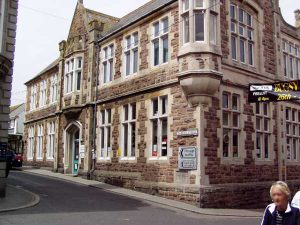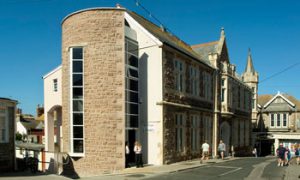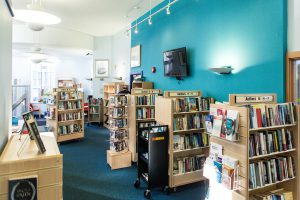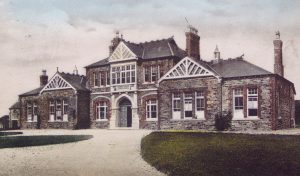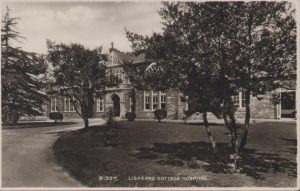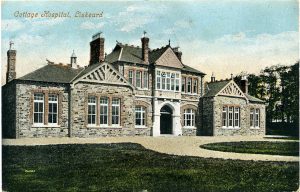“On Thursday, before visiting Chacewater, Mr Passmore Edwards, with his wife, son and daughter, went to Mithian, where they made a brief stay in order that Mr Edwards might open the pretty little Institute which has been erected there. The necessity of a Institute for Mithian has been long felt by the villagers, and a an effort was made by themselves to supply the want. land was obtained and the walls of the proposed Institute were raised, but through lack of funds no further progress could be made. Mr Passmore Edwards was appealed to, and at once communicated with Messers F Symons & Son, Blackwater, who were instructed to complete the unfinished structure. At the same time Mr Edwards expressed regret that the foundations would not allow a larger and more commodious building being erected. However, the little institute is much appreciated, and through the kindness of Mr edwards is well stocked with books. the rooms are divided by a wooden partition, and this can be removed when extra space is required for a concert, lecture , and the like.
The ceremony, although not of the most imposing character, was one to be remembered. The children of the Board school, in charge of Mr P Richards, master, were drawn up in lines, and as the welcome visitors arrived they were met with a shower of little bunches of flowers from the children, who cheered lustily, and then sang a Hymn, their singing showing evidence of careful training. In the afternoon a football match took place, and a public tea was largely patronised.” West Briton, 19 April 1894.©Northcliffe Newspapers Group.
After opening the Institute Edwards responded to the vote of thanks by saying that he had been given more praise than he was due. It had been his privilege in Cornwall and in other parts of the Country to erect buildings but that was the first time he had assisted, and only assisted, to erect a building. When he was told what the expense would be he was almost startled at the small amount mentioned. He was only sorry that he was not earlier made aware of their intentions of the parishioners, for had he been, the building would have been of a slightly more imposing character than the present structure. In concluding he said that he hoped, when visiting Perranporth he would have another opportunity of meeting them. He was due in Chacewater in a short time and his only regret was that he could not stay with them longer.
The villagers cheered them off as Passmore Edwards and his family left Mithian to travel the short distance to Chacewater.
Category Archives: Buildings in Cornwall
The Children’s Wing, Redruth Women’s Hospital 1899
After serving the community for many years the hospital ceased to be required by the NHS. After standing empty for several years the building was restored as a central part of a residential and commercial development.
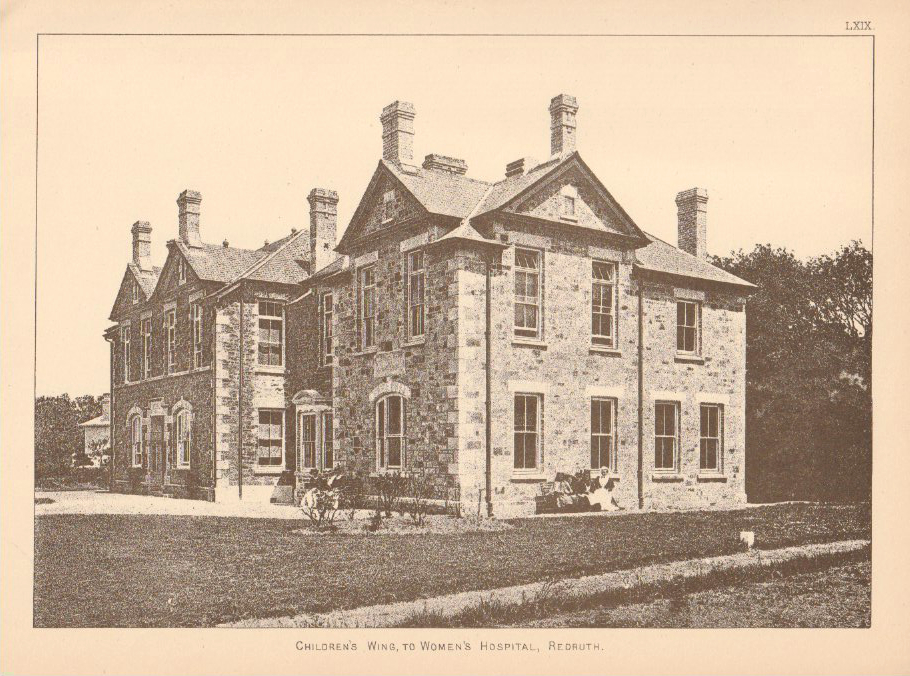
History
Redruth Miner’s Hospital was established in 1863, with money given by Sir Edward Nicholl, and opened on 1 January of the following year. The Rt Hon T C Agar Robartes of Lanhydrock, whose family had interests in the mines around Redruth, gave the site and contributed towards its support. In 1871 an accident department was opened.
Redruth Women & Childrens Hospital, Redruth, awaiting restoration 2004. Lord Robartes continued to support the Hospital, in 1876 providing £774 towards the total cost of £1,069. There were 160 admissions in that year.
In 1887 a Committee was set up to build a Women’s Hospital adjacent to the Miners Hospital. This was opened on 29 January 1890 by Mrs Basset of Tehidy, President of the Hospital,and dedicated by Rev Canon Chappel and Rev J W Lane. Initially women who worked in the local mines and tin streams had priority although treatment was available to all who needed it..
Half of the total cost of building the new Hospital and the total cost of furnishings was given by Mrs Basset, who also contributed £100 per year towards the running costs. The land had been sold to the Committee for a nominal £150 by Gen Sir Redvers Buller, who also gave £100 towards the building costs. Other subscriptions totaled£1.359 12s 6d, including £100 from Mr J Williams of Caerhays Castle, £100, Lord Clinton, £50, Lord Robartes, £50, and Mr G Williams, of Scorrier, £20.
In digging the foundations of the Women’s Hospital, two roughly circular stones, about two feet in diameter, were uncovered together with wood ash and other stonework walling. This was believed to be the original tin smelting works, or Blowing House, from which the area derived its name.
In 1898 Passmore Edwards, together with Mr Edward Trousnson, gave money for the addition of a Children’s wing to be attached to the Women’s Hospital. This was opened the following year.Both Hospitals were amalgamated in 1901.
A maternity unit was added in 1926 and further additions made in 1928 and 1935. In 1938 a Redruth Hospital Coronation Extension Appeal was issued which raised £4,564 plus £15,000 from Commander Sir Edward Nicholl. A further £750 was donated to the Radium Fund. The new extension was opened in 1939, costing £32,000, and bringing the accommodation up to 79 beds (18 men, 27 women, 8 children and 10 private patients. An extra 43 beds were made available during the WW2.
By the time of Queen Elizabeth’s Coronation, in 1953, the Hospital had 151 beds and was treating over 3,000 in patients and 31,000 out patients each year. However, a gradual run down commenced in the 60’s when, in 1966, all adult medical surgical cases were transferred to Treliske Hospital at Truro and children sent to Truro City Hospital.
The casualty department was also moved to Truro since there was no medical or surgical staff now at the hospital and the maternity unit closed in 1978. The hospital closed in the 1990’s.
Architect unknown
Current use
The hospital site stood vacant for several years and was subject to vandalism and arson. Eventually the site was redeveloped as part of the Gweal Pawl Estate. Carried out by Percy Williams & Sons, this combined the restored existing buildings with new housing development, managed by the residents.
Passmore Edwards Science and Arts Schools, Helston 1899
Passmore Edwards originally offered the peiople of Helston a Free Library but they said that they would rather have a Science & Arts School.
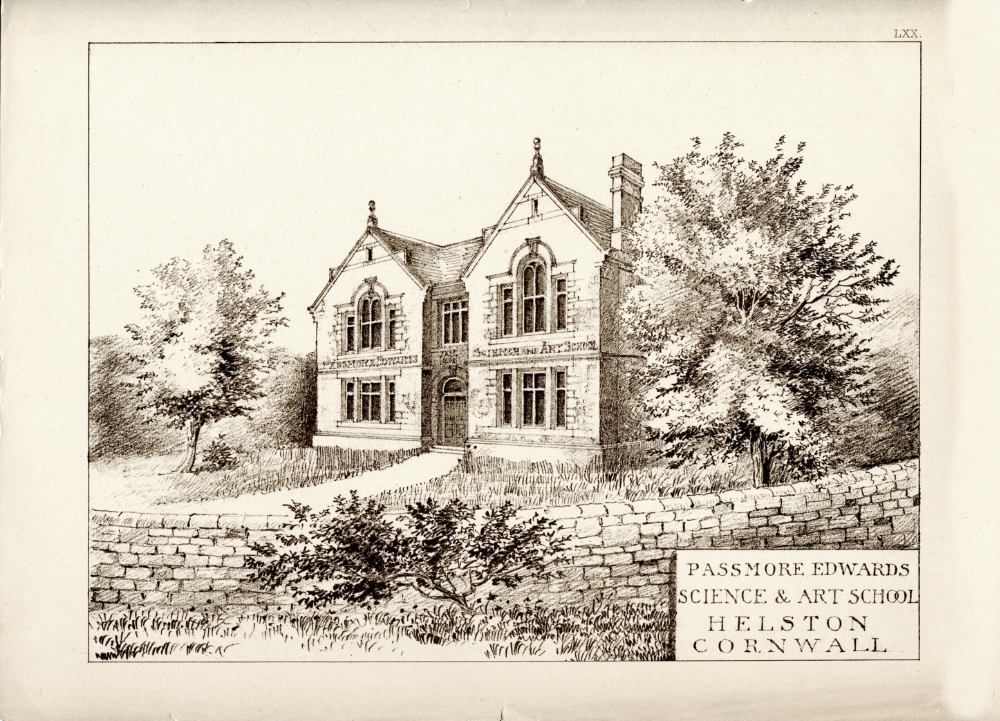
History
The schools, built on a commanding site, were publicly opened by Passmore Edwards in May 1899. The Mayor- Mr. E A Pengilly- members of the Corporation, mayors from Cornish towns, freemasons and members of Friendly Societies, ministers of religion, magistrates and others joined in a procession from the Town Hall to the new Science and Art Schools, in honor of the event. After the formal function of opening the institution, and at a luncheon which followed, presided over by the Mayor,
Mr. R G Rows, JP, moved the following resolution:- “That this meeting expresses it high appreciation of the generous assistance which Mr. Passmore Edwards has given to science and art teaching in the county of Cornwall, and rejoices that Helston has been included in the list of places receiving his benefactions. It assures him that the Science and Art Schools which he has erected in this borough is already serving an important purpose to its inhabitants and promises to be of great and permanent value.”
He, Mr. Rows, was glad to tell them that the building was erected on a freehold site which had been generously conveyed to the Corporation in trust for technical education purposes. In many parts of Cornwall, the institutions erected by Mr. Edwards were sources of sweetness and light to the people of their respective neighborhoods. The Hospital and the home illustrated his care for the bodies of the people, whilst the Free Library and the technical Institution demonstrated his care for their minds. Whenever he had planted technical schools, his laudable acts had been followed by a quickened interest in the subjects taught.
Canon Tyact, in seconding the vote, said that the institutions Mr. Edwards had founded would ever keep his memory green in Cornwall.
Mr. Passmore Edwards said that he was pleased that he had responded to the wishes of the people of Helston by erecting in the town Science and Art Schools, because the building in the broadest sense was public property. It was somewhat remarkable that Liskeard was the only town in Cornwall, and as far as he knew, in the kingdom, that had accepted and adopted and taken under its control a hospital as municipal property, and now the Corporation of Helston had followed suit by accepting and adopting Science and Art Schools, and thereby contracted an obligation to maintain them for the public advantage. By so doing, Liskeard and Helston had presented illustrations of civic wisdom and courage. If corporate authorities in all parts of the country used the powers they possess, by owning and controlling gas and water works, tramways, public libraries, schools for primary and technical instruction, and for providing improved dwellings for workers, local patriotism would be developed and strengthened and the general community benefited. It was a healthy sign of the times to see Helston, with its four thousand population, so far away from the great centres of political and industrial activity and the great towns which were supposed to particularly throb with national life, exhibit so much civic interest in technical education and so cheerfully fall in with the trend of the times, a fact for which they had particularly to thank their eloquent and eminent fellow-townsman, Mr. R G Rows.
From “Passmore Institutions, Founding and Opening Ceremonies, by J J McDonald, 1900”.The Helston Corporation responded to Passmore Edwards’ offer of a Free Library by asking for an Arts & Science school instead. He readily agreed and a part of the garden of the former Helston Grammar School was acquired freehold from Captain Rogers of Penrose, on the payment of one shilling a year. Edwards offered to pay the £1,600 construction costs but, as usual, expected the community to pay £300 for the furnishings and fittings. He even suggested where the Corporation might go to secure donations, mentioning Lord Robartes and John Williams of Scorrier.
Although there are four foundation stones set into the front of the school, they are not engraved, as there was no ceremony to lay a foundation stone. And although the date 1897 is displayed above the door, it was 12 May 1899, more than 12 months after the school was completed, that Edwards visited Helston to formally open it. It was his first, and probably his only visit to the town, James Hicks, the architect, having made the necessary arrangements with the Town Council.
As was the Cornish fashion, the Mayor – Mr E A Pengilly, members of the Corporation, mayors from other Cornish towns, freemasons and members of Friendly Societies, ministers of religion, magistrates and many other worthies joined in the procession from the Town Hall to the new Science and Art Schools. Presented with an engraved silver key Edwards declared the school open, saying that if the key typified the school’s beauty and utility then it would answer its purpose.
With the formal opening of the school completed the party withdrew for a luncheon, and the customary speeches and toasts. In response to a vote of thanks Passmore Edwards said that he had been pleased to erect a Science and Art School in Helston, because ‘the building in the broadest sense was public property’. Liskeard was the only town in Cornwall, and as far as he knew in the country, to take under its control a hospital as municipal property, and now the Corporation of Helston followed with the Science and Art Schools; accepting an obligation to maintain them out of public funds. This, he said, was a step in the right direction for true socialism. This he called Corporation Socialism and ‘the more they had of it the better’.
Though he declared himself a loyal member of the Liberal Party, he did not use the word ‘radical’, in later life he moved towards the new socialist movement. He supported the trades unions, subscribed towards supporting industrial action, promoting the new socialists such as Kier Hardie, who he praised for his honesty and resolution, and funding Independent Labour Party Candidates, though there is no evidence that he joined the ILP.
The festivities at Helston continued into the evening with seventy ladies and gentlemen sitting down to dinner at the Angel Hotel. During the dinner Edwin Durning Lawrence, Liberal Unionist MP for Truro, who presented the schools with a lecture table for the Technical School and two scholarships for the Art School, spoke about Parliament and the House of Lords. On hearing Lawrence say that the House of Lords had always been filled with great artists, like Lord Leighton, great poets, like Tennyson, and great men of science, like Lord Kelvin, Edwards replied that these were exceptions, showing his general dislike of those that populated what he called the ‘House of Landlords‘. When Lawrence continued in his praise of the present Government, Edwards interrupted him to ask whether this was an electioneering speech. ‘No Sir’, said Lawrence. ‘Well I object to it’ replied Edwards. Lawrence, trying to recover his position, said that he had perhaps been led astray by talking as he did. He only desired to say that he would always do what he could for Cornwall. He supported the Government because he thought it was doing the best for the country. Edwards was not to be won over. Desiring not to throw a note of discord into such a gathering, he said that he was ‘a Party man’, a strong party man, but he had never, in any speech he had made on any similar occasion showed to which party he belonged. They should remember that they were all assembled as Cornishmen, as Englishmen and as citizens of the British Empire, rather than to show any proclivity to one side or the other. Although this was met with applause, the West Briton commented the following week that the harmony of the evening had been sadly disturbed by Edwards’ rebuke and that ‘opinions will differ as to whether he had been justified in his action‘. Certainly Lawrence did not seem to be too upset by the occurrence as the following week, when speaking at the Royal Institute for Cornwall meeting in Truro, he spoke of them being near a great educational building, the new Technical school, founded by a man who was not yet a styled saint but had built these great establishments in many parts of the country. He referred, of course, to Passmore Edwards.
The Helston School was soon over taken by amendments to the education acts and, taken over by the County Council, it was enlarged in about 1904 and again 10 years later to form a County secondary school, remaining in use until the 1970s.
Architect
Current use
Following the closure of the school in the 1970s the original Passmore Edwards building and the adjacent secondary school was for many years used as the home of the Helston Community Centre.
Whilst not an Arts & Science School, the Community Centre met Passmore Edwards’ original aims in that it was Helston Adult Education’s prime daytime venue for classes in Helston with up to 15 adult classes taking place every week. In addition many local organisations made good use of the building. A children’s preschool was located there for 30 years and a ballet school with over 180 pupils held classes there, six days a week, for 15 years. The arts were also represented by the use made by amateur dramatic groups from across West Cornwall and it is even used as rehearsal space for the internationally famous Flora Day celebrations.
In 2008 the Community Groups were told that the building was to be sold by the Town Council and they were given notice to quit. The reason given was that the original conveyance of the land to the Corporation was for Technical Education purposes and, according to the present Trustees, the Helston Town Council, require that one third of the present building is used for “Science” purposes. Since, they said, they could not find a way around this obstacle they were not prepared to renew the lease to the Community Association but proposed selling the building and with the money raised, build a replacement community centre at some time in the future.
The local community groups, faced with being turned out of their beloved community centre contested the Council’s decisions and took legal action. Whilst the matter was still in Court the Helston Town Council offered to sell the building to the Community Association but funds were not available to them.
Current Use
The building was eventually sold to the The Cornubian Arts & Science Trust ( CAST ), an educational charity established in 2012 and the Trustees raised sufficient funds to carry out urgent repairs so that the building could be brought back to like. Since then a major grant of £499,000 has been received from the Arts Council England. The building is now used as artists studios and performance spaces and there is a very welcoming cafe.
St Ives Free Library 1897
Erected on a site given by Mr. T B Bolitho MP, the St Ives Library continues to serve its residents and visitors alike.
History
After opening the Hayle Institute, and after the obligatory luncheon and speeches, Mr & Mrs Edwards they made their way, together with the obligatory procession of Cornwall’s Mayors and Aldermen, around the bay to St Ives. Here they were met by the Mayor and Corporation, and the thousands lining the gaily-decorated streets. Passmore Edwards was there to lay the foundation stone for the St Ives Free Library, which he did, in the name of “one and all”.
The Borough of St Ives had been swift in accepting Passmore Edwards’ offer of a public library and adopting the Free Library Act, but finding a suitable site was not so easy. Thomas Bolitho, MP for the Western Division of Cornwall, offered the site on which the library was finally built as a gift, and where it still has pride of place in this busy little Cornish seaside town.
Passmore Edwards again instructed his friend John Symons to both design and build it, Frank Symons preparing the plans and borrowing features both from Trevail and James Hicks’ work. By January 1897 the library was complete and handed over to the Corporation but it was not until April that the official opening took place. Passmore Edwards was invited to carry out the opening ceremony but replied that he could not travel all the way to St Ives for just one building and so the honour of opening the library fell to Bolitho.
The front elevations are of pink Elvan stone on a granite dressed plinth and with Bath stone dressing. The other walls are of local stone with brick dressing. There is a noticeable influence from Trevail, whilst the corner castellated turret is similar to Hicks’ design for the Redruth library.
Internally, the ground floor was given over to the newspaper and periodical room, lending library and borrowers’ lobby and a boys’ reading-room. A reference library shared the first floor with a committee room, the librarian’s room and the caretakers’ apartment. Ladies not wishing to use the main library rooms could also use the Committee room.
Architect
Current use
The choice of building material, though resulting in a much more pleasant design than the more somber Institute at Hayle meant that the library has needed renovation over the years and following transfer to the Cornwall County Council the library has seen several changes. As recently as 2006 refurbishment and extension of the library has taken place to prepare it for another century of service to the residents of St Ives. Now home to the St Ives Art Collection and the St Ives Trust Archive, the renovated library provides the Internet connection and other services required of a library in the twenty first century. Following the Cornwall Council’s review of library services the Town Council took over the running of the library in 2018.
Passmore Edwards Cottage Hospital, Liskeard 1897
After more than 100 years as a hospital the building was restored and became central to a new community housing development.
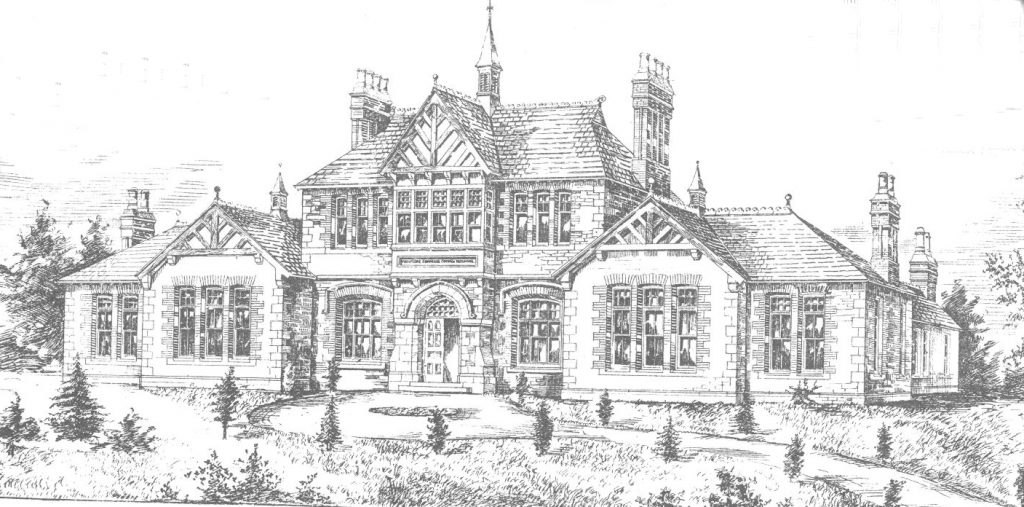
History
Constructed on land given by Mr L Carrington Marshall, the hospital was adopted by the Borough Council from the start and strict codes of conduct were applied.
Medical staff consisted of members of all medical firms resident in the Borough and at least one of these, the “Surgeon of the Day”,was on duty at the hospital at anyone time to attend to all accidents and urgent cases brought to the hospital where these were not accompanied by a doctor.
The medical staff where responsible for the medical management of the hospital but reported to the Committee and were expected to abide by the general code of conduct. Honorary Medical staff consisted of W Nettle, W Hammond, R Hingston and W H St Ledger Carter. W H Lyne was the Honorary Dental Surgeon.
Matron was required to reside at the hospital and to seek the permission of te Committee to take laeve. She was responsible for attending to all patients and for the good conduct of nurses, servants and the patients.
Whilst the poor were treated without charge, other patients were expected to contribute from 1s to 2 guineas “as determined by the Committee”.Family of the patient were reuired to sign an agreement to pay the charges, presumably in case the patients treatment was not successful. Patients were expected to have “decent clothing and proper change of linen.
Those suffering from contagious diseases. epilepsy, TB,or “of unsound mind” were not admitted. Anyone removed from the hospital due to poor behaviour was not readmitted without the consent of the Committee.
The annual report for 1899 showed an income of £195 19s 3d from subscriptions, £9 14s 10d from donations and only £26 10s from inpatients. Out goings amounted to £275 2s 11d, of which £25 15s 9d was for Surgery and dispensary and £90 19s 5d for salaries and wages. A total of 66 patients were admitted of which 45 were cured, 6 “very much improved”, 3 “relieved” and 6 died. Another 12 died “shortly after”.
Patient numbers increased and in early 1914 improvements and alterations to the hospital were carried out to meet the needs. Matron, Miss Gillespie, was called up in 1915, not returning until 1919. Nurse Parker took over whilst she was away on war service. A number of wounded Belgiums were treated free of charge in 1918 and the hospital became a local centre for the treatment of discharged soldiers and sailors at the end of WW1 with a convalescent ward made available to the Red Cross at no charge.
Both Matron and Nurse Parker left the hospital in 1920 and Mrs M E Sanders Sister F Burch took there places.
Electricity was not installed at the hospital until 1925 and with it came X Ray equipment. Extensions to the hospital were carried out in 1927.
Architect
Current Use
In 2002 the hospital closed and services transferred to a new hospital building. Plans by the Primary Care Trust to demolish the hospital, known locally as ‘Passmores’, and redevelop the site for housing were met with protests from townsfolk concerned about the loss of the town’s historic buildings and that this would be the first Passmore Edwards building in Cornwall to be demolished. The Town Council voted to refuse permission for the demolition, but agreed that the building could only be saved if a new use could be found for it; being called Passmore Edwards was not sufficient. A suitable use was found, as part of a sheltered housing complex, and this was opened by the Duchess of Cornwall in 2011, during the centenary year of Edwards death.
Passmore Edwards Institute, Hayle 1896
Built primarily as a place for technical instruction, at a time of decline in Hayle’s prosperity, the Institute also provided a library and an opportunity for leisure activities.
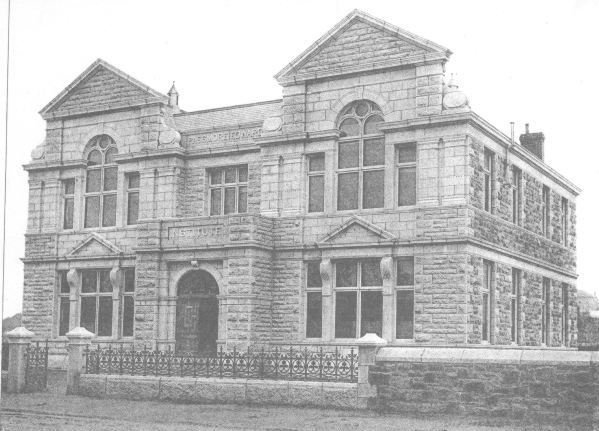
The building is sombre and dignified, the front finished in rock-faced granite, with close chiselled dressings, and the sides are of elvan filling with granite dressings. The windows on all sides are large and uncluttered, classical and expansive in style, contrasting with the formidable Norman Arch porch with its heavily panelled outer doors and the granite balcony above. The leaded coloured glass panels in the top third of the outer doors, and those in the oak framed arch above, let in a warm,
comforting light, though their simple geometric designs are decoration only. The circular pattern of glass and lead above the door is reminiscent of a dart board, an ironic prediction of the predominately leisure use of the building in the future.
The interior is much lighter and brighter than the outside, even on a winters day. There is much use of genuinly rich brown timber for the staircase and panelling up the stairs, set off by plain, plaster walls painted a pale colour.
Description of the Institute taken from “The Hayle Institute” by Patricia Adams, 1996.
Employees of the Harvey’s foundry established a Mechanics Institute but they could not persuade their employer to provide them with premises. Edwards’ brothers and parents moved to Phillack in the 40s, where his father superintended a farm and flourmill on behalf of Messers Sandys Carn & Vivian, and he is known to have visited them on at least one occasion, giving lectures in towns along the route from London to fund the visits. In May 1846 he gave a series of six lectures in Hayle, under the banner of the ‘Pleasures and advantages of knowledge’, in aid of establishing a Literary & Scientific Institute in the town. These were given at the Mount Pleasant Chapel, where his brother, Richard, was Sunday School Superintendent and ‘resulted in a healthy toned excitement in the district as never existed before and which must contribute to the moral and mental elevation of the people’.
Eventually an institute was opened in the old railway station in Foundry Square, to which Edwards donated 100 books.
The new Technical Institute was the first of several commissions for Edwards by the Cornish architect, Silvanus Trevail and was built by John and Frank Symons. The site chosen was on made up ground and this, together with the ambitious design prepared by Trevail brought the cost of the Institute to £3,000, rather more than Edwards was expecting to pay. The Institute at Blackwater had cost him only £250.
In was carnival day on 23 September 1893, the day chosen to lay the foundation stone. The Town Council declared a days holiday and streets and premises were decorated; the festivities going on throughout the day, with an evening tea, a promenade concert and finishing with fireworks.
A procession nearly a mile long made its way from Copperhouse to the site, under evergreen decorated triumphal arches, bearing banners bearing -‘Welcome’, ‘Success to the Institute’ and ‘Long life and happiness’.
Before laying the foundation stone, and dedicating the Institute to the memory of his father, William Edwards, Edwards was presented with an illuminated address, thanking him for the gift of the Institute, and after the proceedings were complete they all retired to the Public Hall for lunch. It was to be another three years before his wife, Eleanor, officially opened the Institute although it was Passmore Edwards who responded to the vote of thanks, on his wife’s behalf.
The Institute was erected to provide education and technical training for local men at a time when Hayle was suffering from a decline in the mining industry, a decline from which Hayle has yet to recover.
Current use
Trevail’s building, sombre and dignified, lacks the elegance of many of his later designs for Passmore Edwards, though what it lacked in looks it made up for in functionality. Edwards said that he was glad to see that it was constructed of Cornish granite, which was one guarantee that it would last for many years and probably for ages. The science laboratories, classrooms and library have long since gone but the Institute still retains a pivotal position within the community. Ongoing maintenance by enthusiastic Trustees and Management Committee will ensure that Edwards’ guarantee is upheld. It undertook a major restoration and was reopened in 2011, 100 years after Edwards death, and continues to serve the community to which it was freely given.
Bodmin Free Library & Art and Science Schools 1897
Erected on the site of the old Hugo’s Temperance Hotel and dedicated to the memory of Sir William Molesworth Bart, of Pencarrow, Cornwall, Secretary of State for the Colonies, 1855
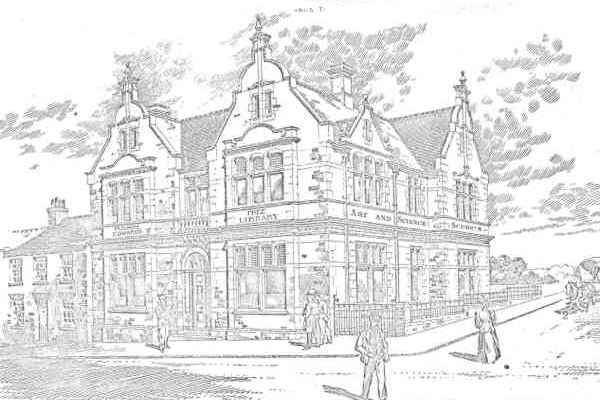
History
“This building is to be erected through the munificence of Mr. J. Passmore Edwards, on a site in Fore-street, Bodmin, acquired from Lord Robartes, at the junction of the road leading to the Beacon, where stands the prominent obelisk to the memory of the late General Gilbert, of the same town. It will be a great improvement to this part of the ancient borough, and is centrally situate for the population. The plan exhibits the arrangement of the ground floor, and the upper story is to be devoted to a local museum and an excellent suite of classrooms for the use of classes in technical instruction in connection with the County- Council scheme of technical education. The walling will be in Margate Wood stone, with Bath stone dressings. The internal joinery will be in pitch pine, varnished. The roofing will be of the Cornish Grey slates, quarried at Delabole, and the base and steps of Luxulyan granite.” This is how the new Bodmin Free Library was described in the “Building News” on 1 May 1896.
Bodmin library around 1900. The Bodmin Free Library was erected on the site of Hugo’s Temperance Hotel and Grocery. The Hotel was licensed to hire out carriages and was formerly the Western Inn which had boasted a landlord named “Seven Belly Williams”. The site was offered to the Town by Lord Robartes for £100.
One of the Institutions opened in the Jubilee Year of Queen Victoria, the library was opened on 24 May 1897 by the Right Hon Leonard H Courtney MP.
As with other libraries of the time books for loan were catalogued and listed on an index. Once the borrower had chosen from the list he ordered the books at the hatch in the Borrowers Lobby on the Ground Floor. The librarian’s assistant would then collect the books from the shelving in the Lending Department. Also on the Ground Floor was the Newspaper and magazine room, the Librarian’s room and the Boys room. This catered for the younger boys still at school and classes were also held there.
On the First Floor was the Committee Room, Periodicals Room and the Ladies Room. There was also a Reference Library and Museum holding “artifacts of interest from within the parish and beyond”.
The ladies room and the periodicals room were divided by a removable partition giving a larger room. These two rooms were let to the Technical Instruction Committee for Science and Art Schools at £10 per annum.
Shortly after opening, on 11 December 1897, the Town Clerk wrote to Silvanus Trevail refering to problems of walls and ceilings “which had fallen down” and to defective Bath Stone on the SW window. Trehane undertook to make good these defects but there was further damage reported when the mullion “fell away” later that month.
The Library Committee were required to approve repairs to the roof in January 1898 and in September of that year repairs were required to the mullions on the North end window. Again, in 1900, the Borough Surveyor reported that the SW Bath Stone window had been gradually giving way with the presure of the weight of the wall above. The lintel had broken in 4 places and the transom and Mullion had also broken. He recommended that the window should be taken down and replaced to prevent further settlement and damage. By the end of 1900 a petition had been signed by 147 library users calling for the repairs to be put in hand.
In 1953 the Cornwall County Council took control of all libraries in the County. As demand on the library changed, changes to the internal arrangements were made to reflect these. Borrowers could choose their own books and to create a larger area where the books could be displayed part of the internal wall between the newspaper room, borrowers lobby lending department and librarians room was demolished. This large room was filled with fixed shelving in rows. Little alteration was made to the first floor although the use of the rooms changed to meet the changing needs.
During the 1970’s serious problems with the structure of the building were discovered. Serious cracks in the west wall were detected whilst in 1977 the partial colapse of the ceiling to the first floor store room highlighted an ongoing problem of leaks from the roof through defective lead flashings and valley timbers despite many localised repairs. In 1978 John Garrett & Sons of Truro commenced a 26 week contract to carry out the extensive necessary repairs at a cost of £39,510.
The corner joining the SE and SW elevations had sunken considerably over the years. This settlement opened up cracks in the stonework and caused surface water not to be shed from the area but to towards the foundation.
Roofing repairs were carried out in the 1980’s to replace timber decay due to dry rot, the partial retiling of the roof and lead replacement to a number of vallies and gutters.
In 1989 repairs were found to be necessary to deal with cracks in the rear, South, wall. This, which controversially involved the removal of the rear wall in its entirety and replacement with a modern rendered, cavity block wall and the original soft wood windows replaced with Upvc. Davey (Wadebridge) Ltd carried out the work at a tendered cost of £26,000.
In June 1989 the Area Building Surveyor reported to the County Architect that “as a result of considerable expenditure over the last few years on such items of rebuilding external walls, rewiring, partial ceiling renewal and new floor coverings, the building is now in a reasonable condition” He, however, concluded his report by stating that “The front wall is subject to movement, possibly outwards and may eventually require very extensive remedial work. The soft wall and ornamental parapet stonework is subject to steady weather damage. A hard frost after a wet period may involve some expense”.
Current Use
The library service was moved to the new council offices at Chy Trevail, on the former St Lawrence’s hospital site in February 2017 leaving the Passmore Edwards building vacant. In September 2018 InBodmin, a not for profit Community Interest Company we re-opened Bodmin’s old Library “as an accessible and vibrant performance and community space, promoting the arts, culture and community cohesion through access and participation. Utilising the existing layout, the small scale community arts centre houses a cafe, offering locally produced food and drinks with an emphasis on healthy eating and quality produce. In the same space there is a small stage for live music, cabaret, comedy, spoken word, talks and, potentially, small-scale theatre and dance”.
The Opie Memorial Gallery Newlyn 1895
“If you want to discover the value of the Passmore Edwards Gallery look around you; if you want a monument here it is on the walls”
The Right Hon Leonard Courtney, MP, 22 October 1895
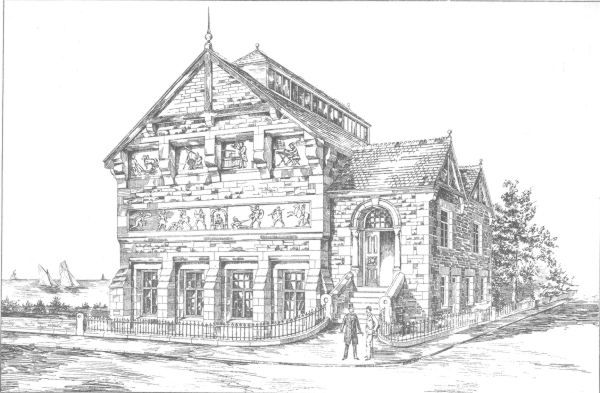
History
On the day that Passmore Edwards opened the Redruth Library, in 1895, he was approached by a deputation of artists from the Newlyn Art Colony, including Stanhope Forbes, and asked for assistance to provide an Art Gallery in Newlyn. Married to the daughter of an artist, Passmore Edwards had, the previous year, funded the construction of the South London Art Gallery and after making the usual enquires about the upkeep of such a gallery agreed to the proposal. The site, on the sea front at Tolcarne in Newlyn, was given by Charles D N LeGrice with James Hicks chosen as the architect and Passmore Edwards’ schooldays friend John Symonds the builder.
It was through the building of the Gallery that Passmore Edwards, in April 1895, found himself, together with John Symonds, summoned to appear before the West Penwith Magistrates for a breach of the bylaws. Due to a misunderstanding as to the local authority area in which the site fell, had delivered the plans and specification to the Paul Urban Council rather than the Madron Urban District Council. By the time the mistake had been discovered construction of the foundations had been commenced, at that time an offence. Mr J B Cornish appearing for Passmore Edwards reminded the Bench of his client’s generosity to others and told them of his regret over this innocent breach of the bylaws. As soon as he had heard of the problem he had discontinued building operations. Mr Cornish hoped that Mr Edwards might reconsider his decision, because it would be very unfortunate if this mistake was to deprive Newlyn of such a building. Despite this set back the building was completed within six months and, on 22 October 1895, the Right Honorable Leonard Courtney, MP opened the Gallery in the presence of Lord and lady St Levan, Mr T B Bolitho, MP, and Stanhope Forbes, ARA, and dedicated the building to John Opie, the Cornish Artist.
The artists had formed themselves into The Newlyn Society of Artists and were closely involved in the design of “their” Gallery. James Hicks’ original design was modified in several ways as is apparent by comparing the original drawing published in J J MacDonald with a photograph. Internally the reading room vanished from the final plan, a move that did not find favour with many locals.
When Passmore Edwards laid the foundation stone he had used a trowel “not of the ordinary silver type but one “of artistic design in beaten metal- a mixture of tin and copper – an example of repoussé work produced in the Colony” and was later shown the art classes at work. Hicks’ design included for the façade to be decorated by carved frieze work but the artists clearly wanted work relevant to Newlyn and the Art Colony. The result is the four decorative copper plaques representing “Earth”, “Wind”, “Fire” and Water”. Designed by two of the Newlyn Colony of Artists: J D Mackenzie, and T C Gotch, the panels were beaten by Philip Hodder. Hodder had been taught the art of repoussé copper beating at the Industrial Class, in Newlyn, by John Pearson. The completed building showed clearly the influence of the Arts and Crafts movement.
Whilst the Free Libraries could rely upon the “penny rate” to support them there was no such support for the Newlyn Art Gallery and the history of the Gallery is one of continued financial insecurity. A full account of the Gallery and its artists can be found in “100 Years in Newlyn, A Diary of a Gallery” Edited by Melissa Hardie and published in 1995 to mark the first Centenary of the Gallery
The Opening Exhibition at the Gallery took place in November 1895 when over 140 paintings were exhibited. Records suggest that 27 of these were sold and commission to the Gallery amounted to a little over £32.
Until the 1950s the Gallery was managed by a Committee appointed by both the Newlyn Society of Artists (NSA) and the Trustees of the Passmore Edwards Art Gallery. The LeGrice family has remained Trustees throughout. Whilst the money to run the Gallery was generated by the artists, and supported by the members subscriptions, the responsibility for the maintenance of the building fell to the Trustees. Except for repairs, the addition of electric light, indoor plumbing, heating and periodic redecoration, no major structural changes were made until the early 1950s.
The importance of the role of Stanhope Forbes in not only the founding but the continued existence of the Gallery was recognised by the sculptured panel, by the Reverend Allan Wyon, affixed to the front of the building and unveiled in 1948 by Sir Alfred Munning, RA.
In 1921 the Committee was extended, at the suggestion of Charles LeGrice to include lay members in a move to provide wider support. After WW2 the Committee was again expanded to 12 members and the Trustees handed over the responsibility for maintenance of the building to the artists. This was finalise in 1959 when the Chairman of the NSA became ipso facto the Chairman of the Gallery Committee, with the Trustees appointing a one liaison person to represent their interests. The position as either Chairman or Committee member was, however, not so much an honorary post but meant numerous hours of not only organising the exhibition space but also, at times, physically cleaning or redecorating the building.
The financial contributions from sales commissions and members subscriptions were rarely sufficient to give the Gallery the security needed, even when added to by a multitude of fundraising activities and so grants were sought from wherever possible, including the Arts Council, South West Arts and the Carnegie Trust and the Henry Moore Foundation.
In the mid sixties, under the direction of John Miller, artist and architect, a second hand spiral staircase, purchased from Penzance Library, was installed, enabling the lower gallery to be employed as an exhibition space, rather than meting room and studio. At the same time interior walls in the upper gallery were moved to give a more attractive format. Later the staircase was resold and replaced with the central staircase leading to the lower gallery and visitor toilets. “Wider vistas and perspectives opened up, and a feeling of space and airiness was achieved”. In 1973-4 new lower galleries, the Harbour Room and the Green Room were formed after the curator’s residential accommodation was dispensed with.
It was at this time when it was decided that the Newlyn Gallery should be amalgamated with the Orion Gallery, a relatively young gallery in Penzance run by Ella and John Halkes and so in 1974 the Newlyn Orion Galleries Ltd was formed under John Halkes as Director. Application to become a charitable Trust followed which opened up scope for further funding and in 1977 the Newlyn Orion became a registered educational charity.
A new era in the Gallery’s existence began in 1993 with the award of grant of £87,000 from the European Union, Regional Development fund, some 50% of a the cost of the proposals to upgrade and modernise the Newlyn Gallery. Matched funding was obtained from the Penwith DC, Foundation for the Sports and Arts, Rural Development Commission, Henry Moore Foundation, Penzance Town Council and Lloyds Bank. A temporary gallery was opened whilst work was carried out and the Gallery reopened on 16 May 1994, almost 100 years after the original opening.
Architect
Passmore Edwards Literary Institute, Chacewater 1894
Dedicated to the memory of Passmore Edwards’ brother, James, the Chacewater Institute remains a feature of the Chacewater highstreet, although not today used for the purpose for which it was provided
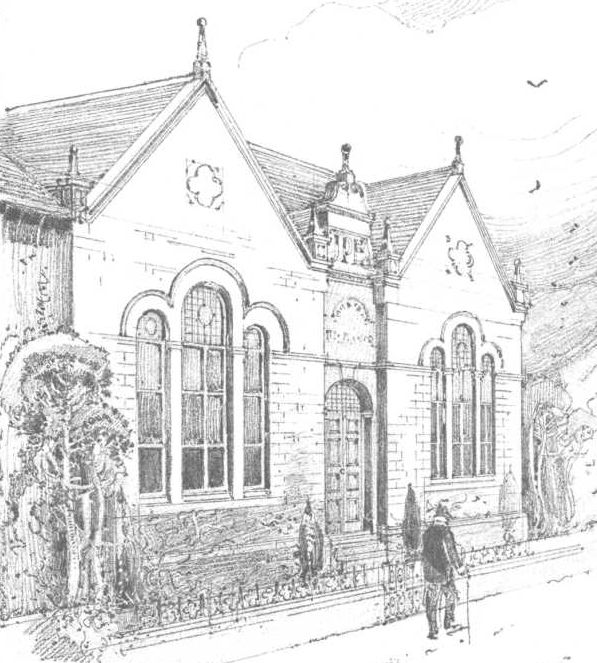
“This building, the foundation stone of which was laid on September 21, 1893, by Mr. J. Passmore Edwards of London, the proprietor of the the Echo, etc, who has since not only borne the cost of its erection, but has furnished the building at his own expense, in memory of his brother, James Edwards, who died in Australia, and presented it to the inhabitants of Chacewater-is situated in the most central part of this charming little town, and on a site given by Lord Falmouth.
It comprises a billiard room, 25ft. by l8ft., reading-room, l8ft. by 19ft,
committee-room, 18 by 14. The last two rooms are divided by a strong framed, panelled, folding, wood partition, and can easily be converted into one large room, and made available for the purposes of concerts, lectures, etc. The building also comprises a cloakroom, lavatory, storeroom etc, the whole of the rooms being well lighted and ventilated. On entering the building, which is approached by a flight of granite steps, the lobby is divided from the hall by means of a glass screen, the panels of which are filled in with rolled cathedral glass in strong Leads. The dressings in the main front of the building are of good Cornish granite, and the fillings a rock-faced elvan, squared, and built in random courses. The jambs which support the arch over the entrance doorway are of granite, also the inscription panel and pediment over it, which bears the monogram, “J. P. E.” and date, which are cut in raised letters. The copings, finials, and pedestals to front gables, and label moulds around windows, are also of granite. The front windows are glazed with rolled cathedral glass, the upper parts with strong lead lights and patent ventilators. The roof timber on the inside is open, and where exposed to view is stained and also the cornices around the room.
All other woodwork in the interior of the building fitted with good red deal and pitch-pine; all floors are of wood, excepting the lobby and hall, which are laid in black and red tile. The building is set back from the main street, and inclosed by a low wall built in character with the main front of the building, with granite coping on top, and fitted with a neat iron railing and a pair of gates. Extract from Building News, 13 April 1894.
Current Use
Current use
The Institute stood unused and in a poor state for several years. The land had been gifted by Lord Falmouth and in common with many similar gifts the Deed of Gift contained a clause that if no longer used for the original purpose the land and building would revert to the Tregothnan Estate. Eventually it was sold and restored to provide two apartments.
St Agnes Miner’s & Mechanics’ Institute 1895
In 1891 Dr William Whitworth wrote to Mr Passmore Edwards seeking his help to provide a Miners’ and Mechanics’ Institute. Mr Edwards replied that he had wanted to do something for the parish of his birth for a long time and would be more than pleased to supply a building.
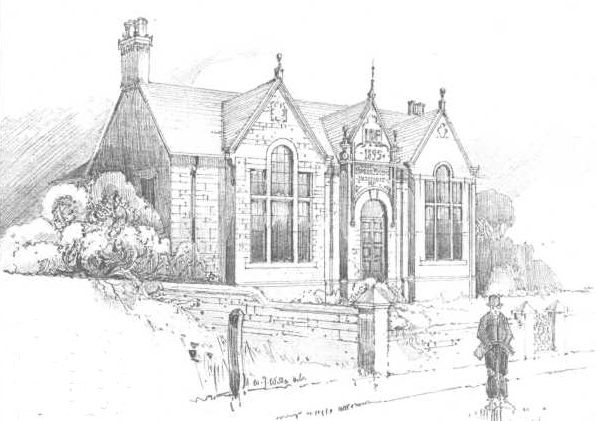
“This building, which has been erected by Mr.J Passmore Edwards in memory of his brother, William P. Edwards, who died in London, and presented to the inhabitants of St. Agnes, his native parish, is situated on the side of the main thoroughfare leading to the town, and is built on land purchased, also by Mr. Edwards, of Mr. J. G. Engs, which has a very commanding position”.
“The building comprises billiard-room, 24ft. by 18ft.; reading-room, 24ft. by 18ft; committee-room, l6ft. by l4ft., together with hall-lobby, lavatory, cloak-room, store-room, etc and, being in an elevated position, is approached by a flight of granite steps. The dressings in front are of granite closely chiselled, with fillings of good local quarry stone of a dark brown colour with natural faces, nicely squared, and built in random courses. All other walls are built in random nobbling. The coping to gables, finials, and stringcourses are of granite finely cut, also archway in front entrance, over which there is a massive granite pediment, with suitable mono-ram and date cut thereon in raised letters. The roofs on the inside are open-timbered, and are stained and varnished. On entering the building there is a suitable glass screen dividing the lobby from the hall, with marginal leadlight work introduced, having a very nice effect. All the interior woodwork is of red and pitch pine varnished. The hall and lobby floors are laid in tile. The whole of the rooms are well lighted and ventilated, and the windows have marginal transom lights filled in with rolled cathedral glass in approved tints. The grounds are inclosed with a strongly-built wall, with heavy rockwork granite coping; the main posts of rock face a granite, with a massive cast-iron gate to entrance, the whole forming a complete finish to the building”. Extract from Building News, 13 April 1894.
